                                                                      
|
|
Journal
of Biomedical Nanotechnology
|
| Vol.
1, No. 4 (December 2005) |
EDITORIAL
What
is next for Nanotechnology?
Vinod
Labhasetwar
Editorial
Full
Text - PDF
Purchase
Article
RESEARCH
ARTICLES
Computer-Aided
Molecular Modeling: A Predictive Approach in the Design of
Nanoparticulate Drug Delivery System
Padma
V. Devarajan, Ganeshchandra S. Sonavane, and Mukesh Doble

The
present study demonstrated Computer-Aided Molecular
Modeling as a predictive approach in the design of
polymeric nanoparticulate drug delivery systems.
Pages
375–383
Abstract
Full
Text - PDF
Purchase
Article
Fabrication
of Microfluidically-Accessible Planar Nanoholes on
Elastomeric Substrates
Nicholas
L. Stucky, Chihchen Chen, T. Fettah Kosar, and Albert Folch

Here
we present two novel fabrication techniques for creating
poly(dimethylsiloxane) (PDMS) devices with an array of
planar nanoholes designed for multiple, simultaneous
single-cell probing. Each nanohole can be addressed by an
underlying microchannel network, which provides
nanometer-scale precision and favorable optical properties
while allowing for low fluidic and electrical resistance.
Pages
384–391
Abstract
Full
Text - PDF
Purchase
Article
Efficient
DNA and Peptide Delivery by Functionalized Chitosan-Coated
Single-Wall Carbon Nanotubes
Arun
Kumar, Prasanna K. Jena, Sumita Behera, Richard F. Lockey,
and Shyam Mohapatra
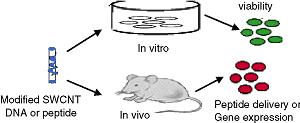
Functionalized
single walled carbon nanotubes were complexed with
nanochitosan and used for the delivery of DNA encoding
EGFP reporter protein and FITC-labeled peptide. Cultured
lung epithelial cells and bronchoalveolar lavage cells of
mice administered with f-SWCNT show enhanced delivery of
peptide and DNA as compared to chitosan alone.
Pages
392–396
Abstract
Full
Text - PDF
Purchase
Article
Quantifying
the Influence of Surface Coatings on Quantum Dot Uptake in
Cells
Emmanuel
Chang, William W. Yu, Vicki L. Colvin, and Rebekah Drezek
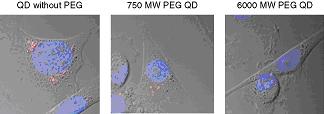
Photoluminescence
is used to quantify quantum dot uptake by SK-BR-3 human
breast carcinoma cells as a function of quantum dot
surface coating, concentration, and incubation time.
Results demonstrated significant differences in
nanoparticle uptake based on surface coatings,
concentration, and incubation time.
Pages
397–401
Abstract
Full
Text - PDF
Purchase
Article
Cell
Culture on a Carbon Nanotube Scaffold
Naofumi
Aoki, Atsuro Yokoyama, Yoshinobu Nodasaka, Tsukasa Akasaka,
Motohiro Uo,
Yoshinori Sato, Kazuyuki Tohji, and Fumio
Watari

Carbon
nanotubes were applied for a scaffold for cell culture.
Cells on the carbon nanotube scaffold showed excellent
proliferation with extension of cell morphology in all
directions.
Pages
402–405
Abstract
Full
Text - PDF
Purchase
Article
Tc99m
Doped Nano-Hematite for Lung Photoscintigraphy
Prashant
D. Sawant and Smita P. Sawant
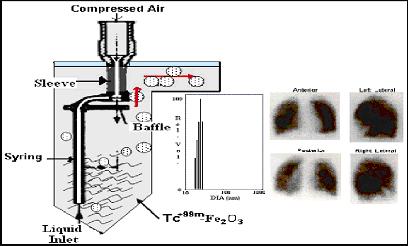
30
nm α-Fe2O3 particles
prepared by the forced hydrolysis method, tagged with Tc99m
and used a nano-phosphor material to image lung using the
lung photoscintigraphy method. Nanosize α-Fe2O3
particles have many advantages over other phosphor
materials and useful in diagnosis of lung diseases.
Pages
406–409
Abstract
Full
Text - PDF
Purchase
Article
Plasminogen
Activator Loaded Magnetic Carriers for Stroke Therapy: A
Mass Balance Feasibility Evaluation
Yumei
Xie, Michael D. Kaminski, Sandra G. Guy, and Axel J.
Rosengart
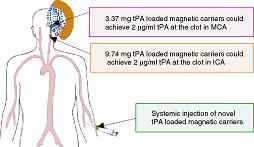
We
are developing a system of clot lysis for stroke treatment
which employs tissue plasminogen activator loaded magnetic
carriers. In this paper we have theoretically evaluated
the feasibility of this therapy. Preliminary experiment
results are also discussed.
Pages
410–415
Abstract
Full
Text - PDF
Purchase
Article
Amperometric
Detection of Glucose Using a Modified Nitrogen-Doped
Nanocrystalline Diamond Electrode
Zhenqing
Xu, Ashok Kumar, and Arun Kumar

A
nanocrystalline diamond electrode is functionalized with
carboxyl group to detect glucose concentration
electrochemically. A linear relationship between the
glucose concentration and the electrode’s response
current has been obtained. The sensor shows pretty good
long term stability and reproducibility.
Pages
416–420
Abstract
Full
Text - PDF
Purchase
Article
The
Volume Property: Hydration in Biosystems
Donald
W. Kupke and Luis A. Marky

In
the simplest case of ion pair formation, release of
constricted water molecules increases the volume of the
system.
Pages
421–428
Abstract
Full
Text - PDF
Purchase
Article
Nanoscale
Analysis of Spatial Organization of Anisotropic Minerals
Stacks in Enamel
Prashant
D. Sawant

The
position sensitive 2D-SAXS and radiography revealed the
nanoscale anisotropic arrangement of mineral particles in
the enamel. These results are useful to understand
mineralization/demineralization/ remineralization
processes in the enamel and hence will be helpful to cure
many oral diseases in future.
Pages
429–432
Abstract
Full
Text - PDF
Purchase
Article
Table
of Contents to Volume 1, Number 1–4, 2005
Pages
433–436
Full
Text - PDF
Purchase
Article
Author
Index to Volume 1, Number 1–4, 2005
Pages
437–441
Full
Text - PDF
Purchase
Article
Subject
Index to Volume 1, Number 1–4, 2005
Pages
442–445
Full
Text - PDF
Purchase
Article |
|
| Vol.
1, No. 3 (September 2005) |
REVIEWS
Pharmaceutical
Aspects of Polymeric Nanoparticles for Oral Delivery
V.
Bhardwaj, S. Hariharan, I. Bala, A. Lamprecht, N. Kumar, R.
Panchagnula, and M. N. V. Ravi Kumar
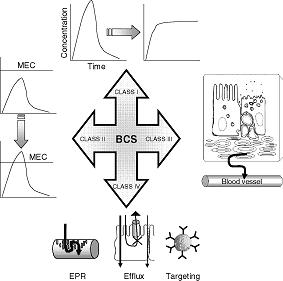
This
review discusses the factors affecting the preparation of
nanoparticles, issues related to their stability and drug
release, various characterization and tracer techniques to
assess their properties and biological fate, applicability
of biopharmaceutic classification system (BCS), and the
various applications in oral drug delivery.
Pages 235–258
Abstract
Full Text - PDF
Purchase Article
Electrospun
Nanofibrous Scaffolds: Production, Characterization,
and Applications for Tissue Engineering and Drug Delivery
Wan-Ju
Li, Robert L. Mauck, and Rocky S. Tuan

This
review has provided a concise and contemporary overview of
the research progress on the application of the
electrospinning technology to produce three-dimensional,
nanofibrous scaffolds for tissue engineering and drug
delivery.
Pages 259–275
Abstract
Full Text - PDF
Purchase Article
DNA
Biosensors Based on Metal Nanoparticles
Yuzhi
Fang, Ying Xu, and Pingang He
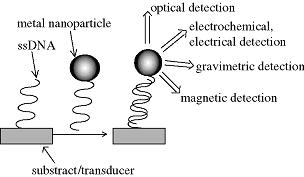
This
review discusses the recent advances in DNA biosensing
techniques based on metal nanoparticles. Different
transduction strategies have been introduced, including
optical, electrochemical, electrical and magnetic
detection methods.
Pages 276–285
Abstract
Full Text - PDF
Purchase Article
RESEARCH
ARTICLES
Nanoparticle
Multilayers: Surface Modification for Cell Attachment and
Growth
Dinesh
S. Kommireddy, Izumi Ichinose, Yuri M. Lvov, and David K.
Mills
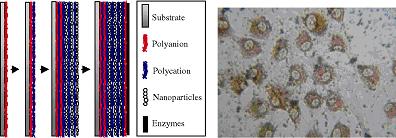
Scheme
for the formation of nano-engineered, ultrathin,
multicomponent films using layer-by-layer assembly (left)
and the expression of the type I collagen, a marker for
the phenotype of human dermal fibroblasts on a
montmorillinoite coated glass substrate (right).
Pages 286–290
Abstract
Full Text - PDF
Purchase Article
Quantitative
Analysis of Bacterial Aggregation Mediated by Bioactive
Nanoparticles
Pengju
G. Luo, Tzuen-Rong Tzeng, Liangwei Qu, Yi Lin, Emily
Caldwell,
Robert A. Latour, Fred Stutzenberger, and
Ya-Ping Sun
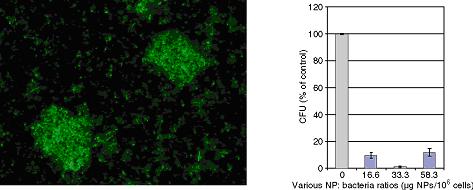
Presented
here are results that quantify the magnitude of cell
aggregation mediated by the mannose-tethered
nanoparticles. The colony forming unit assay suggested a
reduction of up to 99%, consistent with the fluorescence
microscopy images showing large bacterial cell clumps of
hundreds to thousands of bacteria. The potential
applications of the bioactive nanoparticles as
antibacterial agents are discussed.
Pages 291–296
Abstract
Full Text - PDF
Purchase Article
Increased
Skeletal Muscle Cell and Osteoblast Numbers on
Hydrothermally-Treated
Nano-Hydroxyapatite/Collagen
Type I Composites for Entheses Applications
Venu
Perla, Michiko Sato, and Thomas J. Webster
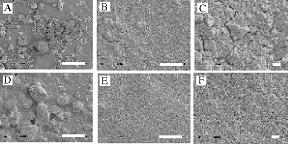
This
manuscript presents data which supports the use of
hydrothermally-treated nano-hydroxyapatite/collagen type I
composites for entheses (regions where orthopedic soft
tissue attaches to bone) applications. Specifically,
increased titanium implant surface coverage and functions
of skeletal muscle cells and osteoblasts were measured on
hydrothermally-treated nano-hydroxyapatite/collagen type I
composites. A–C = non-hydrothermally-treated; D–F
= hydrothermally-treated; A and D = non-aquasonicated; B–F
aquasonicated. Best Ti surface coverage on E and F
(hydrothermally-treated aquasonicated nano HA).
Pages 297–305
Abstract
Full Text - PDF
Purchase Article
Mechanisms
of Increased Chondrocyte Adhesion on Nanometer Surface
Featured NaOH-Treated PLGA
Grace
E. Park and Thomas J. Webster
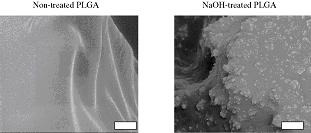
Results
of this study provided a mechanism for increased
chondrocyte function on nanometer surface featured
NaOH-treated PLGA. Specifically, results showed increased
fibronectin adsorption, better infiltration of fibronectin
and vitronectin, and greater fibronectin and vitronectin
spreading on NaOH-treated PLGA (left) compared to
non-treated PLGA (right); all of these initial protein
events may help explain better chondrocyte function on
NaOH-treated PLGA. Bar = 1 μm.
Pages 306–312
Abstract
Full Text - PDF
Purchase Article
Nano
and Micro Structured Substrates for Neuronal Cell
Development
Furqan
Haq, Yeswanth L. Rao, Charles Keith, Yiping Zhao, and Guigen
Zhang
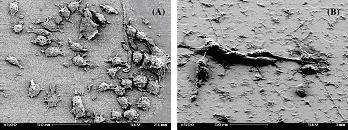
Cells
cultured on nano-substrates (A) developed short and few
neurites with a relatively high density, and cells on
micro-substrates (B) developed long and multiple neurites.
Substrates with topographical features at the nanometer or
micrometer scales may be used to control cell growth.
Pages 313–319
Abstract
Full Text - PDF
Purchase Article
Biosensors
Based on Carbon Nanotubes/Nickel Hexacyanoferrate/Glucose
Oxidase Nanocomposites
Xiaoli
Cui, Guodong Liu, and Yuehe Lin

A
novel glucose biosensor based on carbon nanotubes
(CNTs)/nickel hexacyanoferrate (NiHCF) nanocomposites was
developed in this work. The high sensitivity of the
biosensor is due to the high surface area of the CNTs and
excellent electrocatalytic activity of the NiHCF
nanoparticles.
Pages 320–327
Abstract
Full Text - PDF
Purchase Article
Gold
Nanoparticles do not Affect the Global Transcriptional
Program of
Human Umbilical Vein Endothelial Cells: A
DNA-Microarray Analysis
R.
J. Esther, R. Bhattacharya, M. Ruan, M. E. Bolander, D.
Mukhopadhyay, G. Sarkar, and P. Mukherjee

Treatment
of HUVECs with gold nanoparticles does not change their
global transcriptional program. The figure shows no change
in gene expression pattern between gold nanoparticles
treated and non-treated group with excellent correlation
coefficients. This finding is important for future
clinical applications of gold nanoparticles.
Pages 328–335
Abstract
Full Text - PDF
Purchase Article
Nanoelectrodes
Fabricated from Electron Beam Deposited Carbon
as
Potential Electrochemical Neuronal Probes
Yen
Wei, Houping Yin, Xiaohua Cao, Patrick Ndungu, Guoliang
Yang,
Jean-Claude Bradley, Kambiz Pourrezaei, Peter I.
Lelkes, and Joe Z. Tsien

Nanoscale
electrodes with dimensions as small as 50 nm in diameter
and 1–2 micrometers in length have been fabricated
using electron beam deposition on the tips of
microelectrodes. The nanoprobe was coated with insulating
polymer and re-opened at the extreme tip. The nanoprobes
were demonstrated to be capable of recording neuronal
signals.
Pages 336–340
Abstract
Full Text - PDF
Purchase Article
Control
of Substrate Selectivity Through Complexation and Release of
α-Chymotrypsin from Gold Nanoparticle Surfaces
Joseph
M. Simard, Beth Szymanski, Belma Erdogan, and Vincent M.
Rotello
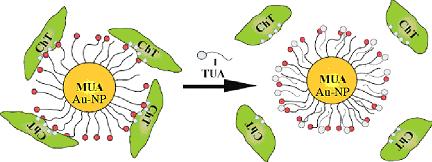
Release
of α-chymotrypsin (ChT) from mercaptoundecanoic
acid functionalized gold nanoparticle with a modified
structure in comparison to native ChT. Released ChT has
altered substrate selectivity.
Pages 341–344
Abstract
Full Text - PDF
Purchase Article
Nanostructure
Formation from a Poly(glutamic acid)-based Helix-Loop-Helix
Copolymer
and its Stable Encapsulation of Antitumor
Reagent
Masazo
Niwa, Keiji Sugamoto, Tomoyuki Koga, and Nobuyuki Higashi

A
poly(glutamic acid)-based triblock peptide with
helix-loop-helix conformation was freshly prepared. The
resultant peptide showed interesting conformational and
self-assembling properties in water.
Pages 345–351
Abstract
Full Text - PDF
Purchase Article
Cytotoxicity
on V79 and HL60 Cell Lines by Thiolated-β-Cyclodextrin-Au/Violacein
Nanoparticles
Iara
F. Gimenez, Maristela C. Anazetti, Patricia S. Melo, Marcela
Haun,
Marcelo M. M. De Azevedo, Nelson Durán,
and Oswaldo L. Alves
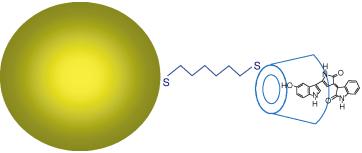
This
research is involved with the use of molecular recognition
properties from cyclodextrin-alkylthiol derivatives
capping gold nanoparticles to complex the antitumor
violacein and its cytotoxic properties on HL60 and V79
cells lines compared with violacein free form.
Pages 352–358
Abstract
Full Text - PDF
Purchase Article
Activation
of Human Monocytes and Mouse Splenocytes by Single-Walled
Carbon Nanotubes
Kazuto
Kiura, Yoshinori Sato, Motoaki Yasuda, Bunshi Fugetsu,
Fumio Watari, Kazuyuki Tohji, and Ken-ichiro Shibata
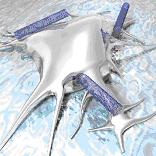
This
study was designed to investigate the biological
toxicities of single-walled carbon nanotubes and
hat-stacked carbon nanofibers that possess different
specific surface areas and graphene structures. These
materials activated both human monocytic cells and mouse
spleen cells to produce TNF-α, although the
apparent activity was significantly lower than that of
microbial lipopeptide and lipopolysaccharide. Thus, these
materials were recognized as non-self antigens that could
trigger an immune responses.
Pages 359–364
Abstract
Full Text - PDF
Purchase Article
Photocatalytic
Killing of Pathogenic Bacterial Cells Using Nanosize Fe2O3
and Carbon Nanotubes
Maheshwar
Sharon, Bonamali Pal, and D. V. Kamat
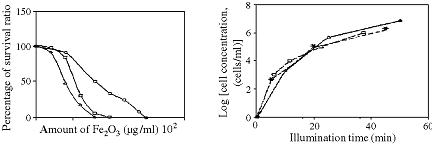
A
photocatalytic technique using visible light and carbon
nanotubes as well as nanosize Fe2O3
powder have been applied to inhibit the growth of
pathogenic bacteria present in water. It is suggested that
after careful design this system can be used to make
drinking water free from pathogenic bacteria.
Pages 365–368
Abstract
Full Text - PDF
Purchase Article
Beads
Screening Method of Inhibitors to Amyloid-ß-Protein
Aggregation
Shun
Inaba, Tomoko Okada, Masaru Eguchi, Takeo Konakahara, and
Masato Kodaka
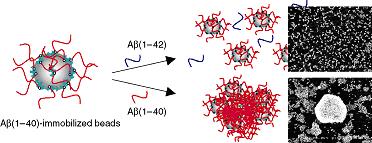
A
method for screening inhibitors against aggregation of
amyloid-ß-protein (Aß) is created, in which
coagulation of beads through molecular recognition of Aß
is applied.
Pages 369–373
Abstract
Full Text - PDF
Purchase Article
|
|
| Vol.
1, No. 2 (June 2005) |
REVIEWS
Electrospun
Nanofibrous Scaffolds for Biomedical Applications
Jonathan
B. Chiu, Yen Kim Luu, Dufei Fang, Benjamin S. Hsiao,
Benjamin Chu, and Michael Hadjiargyrou
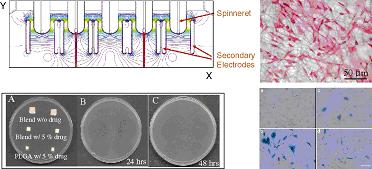
This
review outlines the current state-of-the-art fabrication
of nanofibrous scaffolds via electrospinning and
electroblowing technologies, as well as describing recent
advances made in the production, testing, and potential
clinical applications of electrospun scaffolds in tissue
engineering and drug/gene delivery.
Pages
115–132 Abstract
Full Text - PDF
Purchase Article
Functionalized
Carbon Nanotubes: Towards the Delivery of Therapeutic
Molecules
Giorgia
Pastorin, Kostas Kostarelos, Maurizio Prato, and Alberto
Bianco

This
review is focused on the potential applications of
functionalized carbon nanotubes as viable delivery
devices. In particular, the recent integration of carbon
nanotubes into biological systems has suggested their
potential employment in the delivery of therapeutic
molecules, such as drugs, antigens and genes.
Pages
133–142 Abstract
Full Text - PDF
Purchase Article
RESEARCH
ARTICLES
Sol–Gel-Coated
Poly(methyl methacrylate) as a Substrate for
Localized
Surface Plasmon Resonance Biosensors
Shu-Fang
Cheng, Lai-Kwan Chau, and Kuei-Chen Pao
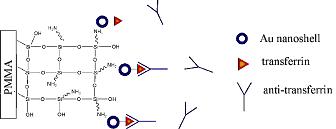
Coating
of an amine-functionalized sol–gel silica film on a
chemically modified PMMA surface enables the formation of
a self-assembled monolayer of gold nanoparticles for
localized surface plasmon resonance biosensing.
Pages
143–150 Abstract
Full Text - PDF
Purchase Article
Chitosan-Alginate
Porous Scaffolds Reinforced by Hydroxyapatite Nano- and
Micro-Particles—Structural, Mechanical, and Biological
Properties
Hassna
R. Ramay, Zhensheng Li, Enoch Shum, and Miqin Zhang
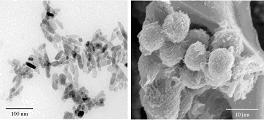
Chitosan-alginate
scaffolds incorporated with hydroxyapatite micro- or
nanoparticles (left) were developed that exhibited good
mechanical and biological properties. Osteoblast cells
attached and proliferated well on the chitosan-alginate
scaffold (right).
Pages
151–160 Abstract
Full Text - PDF
Purchase Article
Arrays
of Microfluidically-Addressable Nanoholes
T.
Fettah Kosar, Chihchen Chen, Nicholas L. Stucky, and Albert
Folch

We
present a batch-fabricated, biocompatible and optically
transparent lab-on-a-chip device that incorporates a
planar array of nanoholes that can be used for electrical
or pharmacological interrogation of large numbers of cells
as well as for precise biochemical delivery to cells. The
nanoholes are defined in a silicon nitride layer using
electron beam lithography and chemical etching techniques.
Each nanohole in the array is microfluidically accessible
and individually addressable from both sides.
Pages
161–167 Abstract
Full Text - PDF
Purchase Article
Enhanced
Intracellular Uptake of Indocyanine Green by
Polymeric
Nanoparticulate Delivery Systems
Vishal
Saxena, Mostafa Sadoqi, Jun Shao, and Sunil Kumar

The
present study demonstrated that ICG-loaded PLGA
nanoparticles enhanced (around 100 times) the
intracellular uptake of ICG in comparison to ICG solution,
especially at low ICG concentrations in B16-F10 and C-33A
cancer cell lines.
Pages
168–175 Abstract
Full Text - PDF
Purchase Article
Folate-Linked
Nanoparticles Formed with DNA Complexes in Sodium Chloride
Solution Enhance Transfection Efficiency
Yoshiyuki
Hattori, Hajime Kubo, Kunio Higashiyama, and Yoshie Maitani
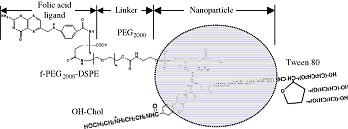
Folate-linked
nanoparticles based on cholesteryl-3β-carboxyamidoethylene-N-hydroxylamine
(OH-Chol) delivered DNA with high transfection efficiency
and selectivity into nasopharyngeal KB cells by forming a
nanoplex in NaCl solution, which influenced the size of
the nanoplex and dissociation of DNA. Schematic structure
of the folate-linked nanoparticles composed of
folate-polyethyleneglycol-distearoylphosphatidylethanolamine
(f-PEG2000-DSPE), OH-Chol and Tween 80.
Pages
176–184 Abstract
Full Text - PDF
Purchase Article
Wet-Chemical
Patterned PZT Force Sensors for Minimally Invasive Surgical
Tools
S.
Ezhilvalavan and Victor D. Samper

This
paper describes a new approach for patterning PbZr0.52Ti0.48O3
(PZT) films that could be used as micro force sensors for
minimal invasive surgical tools. Surface morphologies of
PZT film after wet chemical etching; (a) Optical profiler
and (b) AFM. The microstructure consists of round and
elongated grains with considerable volume fractions of
nano-grains, and the grain sizes are in the range of 40 to
120 nm. The patterned PZT films exhibited good
ferro-electric properties and reliable electrical
characteristics.
Pages
185–189 Abstract
Full Text - PDF
Purchase Article
Micelles
from Poly(ethylene glycol)–Phosphatidyl Ethanolamine
Conjugates
(Peg-Pe) as Pharmaceutical Nanocarriers for
Poorly Soluble Drug Camptothecin
Li
Mu, Adrian Chrastina, Tatyana Levchenko, and Vladimir P.
Torchilin
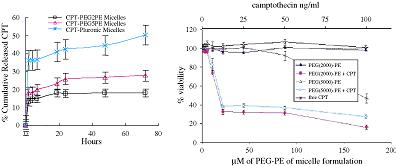
Polymeric
micelles prepared from PEG-PE conjugates may serve as
pharmaceutical nanocarriers for poorly water soluble
drugs, which can be solubilized in the micelle hydrophobic
core. Poorly soluble camptothecin (CPT) was solubilized in
PEG-PE micelles with the formation of stable particles
with the size of ca. 15 nm. The cytotoxicity of CPT-loaded
PEG-PE micelles towards cancer cells in vitro was
significantly higher compared to the free drug.
Pages
190–195 Abstract
Full Text - PDF
Purchase Article
Conjugation
of Monodisperse Chitosan-Bound Magnetic Nanocarrier with
Epirubicin for Targeted Cancer Therapy
Yang-Chuang
Chang, Dar-Bin Shieh, Chien-Huei Chang, and Dong-Hwang Chen
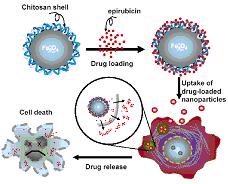
The
monodisperse chitosan-bound magnetic nano-carrier was
developed and conjugated with the anti-cancer drug
epirubicin. In vitro cytotoxicity evaluation
revealed that the novel product has a great potential in
biomedical applications.
Pages
196–201 Abstract
Full Text - PDF
Purchase Article
Electrochemical
DNA Biosensor Based on a
Thionine–Carbon Nanotube
Modified Electrode
Ying
Xu, Lin Yang, Pingang He, and Yuzhi Fang

An
effective CNTs-based electrode is prepared using
thionine-MWNTs modification. The amino groups assembled
onto MWNTs sidewalls covalently link phosphate groups
terminated DNA probes. The modification of thionine-MWNTs
onto glassy carbon electrode improves the detection limit
significantly when daunomycin is used as the intercalator
to indicate the hybridization process.
Pages
202–207 Abstract
Full Text - PDF
Purchase Article
Electron
Spin Resonance Study on the Dynamics of Polymeric
Nanocapsules
Andrea
Rübe and Karsten Mäder

This
electron spin resonance study provides information about
the nanoenvironment of the nanocapsules, the accessibility
of the incorporated spin probes to the aqueous phase and
the kinetics of distribution phenomena in a non-invasive
manner in real time.
Pages
208–213 Abstract
Full Text - PDF
Purchase Article
Loading
of 5-Fluorouracil to Poly(ethyl-2-cyanoacrylate)
Nanoparticles
with a Magnetic Core
J.
L. Arias, V. Gallardo, S. A. Gómez-Lopera, and A. V.
Delgado
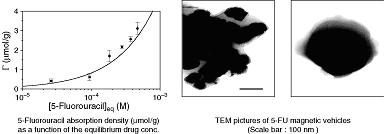
In
this paper we describe a detailed investigation of the
loading of the antitumour drug 5-fluorouracil on composite
particles consisting of a magnetic core and a
biodegradable polymer shell.
Pages
214–223 Abstract
Full Text - PDF
Purchase Article
COMMUNICATIONS
Gold
Nanoparticles Bearing Functional Anti-Cancer Drug and
Anti-Angiogenic Agent: A “2 in 1” System with
Potential Application
in Cancer Therapeutics
Priyabrata
Mukherjee, Resham Bhattacharya, and Debabrata Mukhopadhyay

This
paper reports a functional “2 in 1” system where
activity of VEGF antibody and gemcitabine is retained
after attachment to gold nanoparticles. The nanocomposite
inhibits VEGF165 induced calcium release from HUVECs as
well as inhibits the proliferation of 786-O renal cancer
cells. This formulation represents a unique example of a
nano-biocomposite with potential application of gold
nanoparticles in cancer therapeutics.
Pages
224–228 Abstract
Full Text - PDF
Purchase Article
Targeting
Breast Cancer Cells and Their Metastases
Through
Luteinizing Hormone Releasing Hormone (LHRH) Receptors
Using Magnetic Nanoparticles
Carola
Leuschner, Challa S. S. R. Kumar, William Hansel, and Josef
Hormes

Primary
Tumors and metastases from human breast cancer xenografts
are specifically targeted by ligand conjugated
superparamagnetic iron oxide nanoparticles, incorporated
into the cells and accumulate at high concentrations in
metastases of the lungs.
Pages
229–233 Abstract
Full Text - PDF
Purchase Article
|
|
| Vol.
1, No. 1 (March 2005) |
EDITORIAL
Welcome
to Journal of Biomedical Nanotechnology!
Challa
S. S. R. Kumar
Pages
1–2
Abstract
Full
Text - PDF
Purchase
Article
REVIEWS
Applications
of Carbon Nanotubes in Biotechnology and Biomedicine
Elena
Bekyarova, Yingchun Ni, Erik B. Malarkey, Vedrana Montana,
Jared L. McWilliams, Robert C. Haddon, and Vladimir Parpura
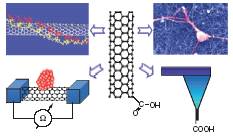
This
review discusses the properties, purification and chemical
modification of carbon nanotubes, and underlines the scope
for their utilization in biosensors, assembly of
functional structures and devices, scanning probe
microscopy, as carriers for the delivery of molecular
probes into mammalian cells, and as substrates for
neuronal growth.
Pages
3–17
Abstract
Full
Text - PDF
Purchase
Article
A
Review of Nanotechnology for the Development of Better
Orthopedic Implants
Grace
E. Park and Thomas J. Webster

This
review covers recent advancements made at the intersection
of nanotechnology and orthopedic implants. Nanomaterials
studied include ceramics, metals, polymers, and composites
thereof. A composite of nanophase titania and
poly-lactic-co-glycolic acid (left) with enhanced bone
cell infiltration needed for implant success (right—cell
are red) are pictured here. In all material cases, bone
cell function is enhanced on nanophase materials.
Pages
18–29
Abstract
Full
Text - PDF
Purchase
Article
RESEARCH
ARTICLES
Sensing
Interactions between Vimentin Antibodies and Antigens for
Early Cancer Detection
C.
Milburn, J. Zhou, O. Bravo, C. Kumar, and W. O. Soboyejo

This
paper examines the use of polysilicon microcantilevers in
the bioassay of Vimentin antigens that are present in
human-osteosarcoma (HOS) cells. The developed method has
potential application in early cancer detection that is
extremely critical to improve cancer treatment.
Pages
30–38
Abstract
Full
Text - PDF
Purchase
Article
Nanoscale
Modification of Supported Lipid Membranes: Synergetic
Effect
of Phospholipase D and Viral Fusion Peptides
Karim
El Kirat, Laurence Lins, Robert Brasseur, and Yves F. Dufrêne

Nanomodification
of a DOPC/DPPC bilayer (left; 10 µm × 10 µm
AFM image) with an AFM tip functionalized with
phospholipase D dramatically enhances subsequent
interaction with the simian immunodeficiency virus (SIV)
fusion peptide: at short incubation time, the SIV peptide
induces a thickness reduction of the DPPC domains, while
at longer incubation time depressed domains transforms
into elevated striated domains (right image).
Pages
39–46
Abstract
Full
Text - PDF
Purchase
Article
Extra-/Intracellular
Biosynthesis of Gold Nanoparticles
by an Alkalotolerant
Fungus, Trichothecium sp.
Absar
Ahmad, Satyajyoti Senapati, M. Islam Khan, Rajiv Kumar, and
Murali Sastry

The
biosynthesis of gold nanoparticles of variable shape using
the fungus Trichothecium sp. is described: reacting
aqueous gold ions with the fungus under stationery
(A)/shaking (B) conditions results in
extracellular/intracellular gold nanoparticles.
Pages
47–53
Abstract
Full
Text - PDF
Purchase
Article
Surface
Engineering of Nano-Fibrous Poly(l-Lactic Acid) Scaffolds
via
Self-Assembly Technique for Bone Tissue Engineering
Xiaohua
Liu, Laura Smith, Guobao Wei, Youngjun Won, and Peter X. Ma

Nano-fibrous
PLLA materials have been developed to mimic collagen in
morphology. Gelatin was immobilized onto the pore surface
of macro-porous and nano-fibrous PLLA scaffolds via a
layer-by-layer technique to impart the chemical
composition of collagen (left: XPS spectra). The surface
modification significantly enhanced osteoblast adhesion
and proliferation in the scaffolds (right: histology).
Pages
54-60
Abstract
Full
Text - PDF
Purchase
Article
Galactosylated
Polymeric Nanoparticles: Synthesis and
Adhesion
Interactions with Escherichia coli
Liangwei
Qu, Lingrong Gu, Huaping Li, Shelby Taylor, Tara Elkin,
Pengju G. Luo, Tzuen-Rong J. Tzeng, Xiuping Jiang, Robert A.
Latour, Fred Stutzenberger, Alicia Williams, and Ya-Ping Sun

Polymeric
nanoparticles of a polystyrene core and polyethylene
glycol corona were prepared via dispersion
copolymerization of styrene with a specifically
synthesized macromonomer. The particle surface tethers
were terminated covalently with derivatized galactose
moieties. Bioactivities of the nanoparticles were
evaluated and demonstrated by their significant adhesion
interactions with several Escherichia coli strains.
Pages
61–67
Abstract
Full
Text - PDF
Purchase
Article
Anodized
Ti and Ti6Al4wV Possessing Nanometer Surface Features
Enhances Osteoblast Adhesion
Chang
Yao, Venu Perla, Janice L. McKenzie, Elliot B. Slamovich,
and Thomas J. Webster

SEM
images of the surfaces of Ti6Al4V before anodization (A)
and after anodization (B). Bar = 1 µm (30,000X).
Results of this study showed that osteoblast adhesion is
enhanced on anodized Ti6Al4V and Ti.
Pages
68–73
Abstract
Full
Text - PDF
Purchase
Article
Sustained
Proangiogenic Activity of Vascular Endothelial Growth Factor
Following
Encapsulation in Nanoparticles
Jasmine
Davda and Vinod Labhasetwar

Vascular
endothelial growth factor encapsulated in biodegradable
nanoparticles (pictured on left) demonstrated greater and
more sustained effect than the protein used as a solution
on endothelial cell proliferation, migration, and
morphogenesis (pictured on right), the key elements of
angiogenesis.
Pages
74–82
Abstract
Full
Text - PDF
Purchase
Article
Increased
Osteoblast Functions on (poly-lactic-co-glycolic acid)
with Highly Dispersed Nanophase Titania
Huinan
Liu, Elliott B. Slamovich, and Thomas J. Webster

SEM
images of nanophase titania/PLGA composites not sonicated
(A) and sonicated at 166.25 W for 10 minutes (B). Bar = 1
µm. Results of this study showed that osteoblast
functions are enhanced on nanophase titania well dispersed
in PLGA composites.
Pages
83–89
Abstract
Full
Text - PDF
Purchase
Article
Vibrational
Modes of Nano-Template Viruses
Alexander
A. Balandin and Vladimir A. Fonoberov

The
rod-shaped viruses such as TMV and M13 bacteriophage have
been recently proposed as nano-templates for chemical
self-assembly of nanoelectronic circuits. In this paper we
report results of our investigation of the low-frequency
vibrations in such viruses immersed in air and water. We
analyze the damping of vibrations in water and discuss
application of the micro-Raman spectroscopy for in-situ
monitoring of the virus-based self-assembly of
nanoelectronic circuits.
Pages
90–95
Abstract
Full
Text - PDF
Purchase
Article
Design
Variations for An Aptamer-Based DNA Nanodevice
Stefan
Beyer, Wendy U. Dittmer, and Friedrich C. Simmel

Aptamers
are promising components of DNA nanodevices. In this
article, a variety of switchable DNA aptamers are
investigated which can bind or release the protein
thrombin upon instruction. The device performance is
strongly influenced by sequence extensions and dye
labeling. A doubly labeled aptamer device is operated as a
switchable molecular beacon which recognizes thrombin.
Extensions on the 3' end destroy the binding capabilities
of the devices.
Pages
96-101
Abstract
Full
Text - PDF
Purchase
Article
Ultra-Sensitive
Detection of Integrin av ß3 Using a Generic Optical
Bionanosensor
Oliver
Worsfold, Chikaho Toma, and Takako Nishiya

Biosensing
Mechanism—In the presence of the target cell, the RGD
ligands incorporated into the fluid bilayer membrane
surface aggregate together. This causes a change in the
fluorescence spectra due to FRET.
Pages
102–108
Abstract
Full
Text - PDF
Purchase
Article
Formation
of Chitin Nanofibers by Supercritical Antisolvent
José
F. Louvier-Hernández, Gabriel Luna-Bárcenas,
Ranjit Thakur, and Ram B.Gupta

Chitin
is dissolved in hexafluoroisopropanol solvent. This
solution is then sprayed into supercritical carbon
dioxide, which rapidly removes the solvent causing chitin
to precipitate as nano-fibers.
Pages
109–114
Abstract
Full
Text - PDF
Purchase
Article
|
|
Terms and
Conditions
Privacy Policy Copyright ©
2000-2012 American Scientific Publishers. All Rights Reserved.
|
|
|
| |
|
|